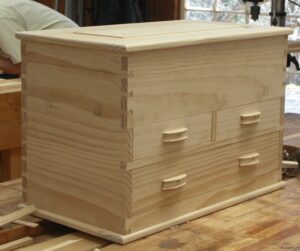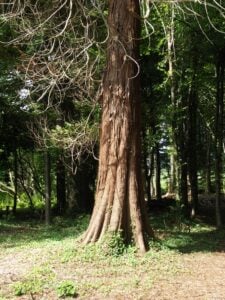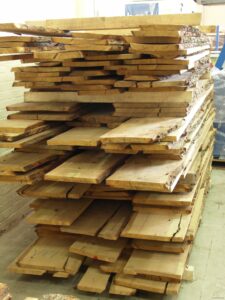Pine

Pine like this is lightweight and strong. Oak would be twice the weight yet not twice as strong and too heavy to lift of course.
There are of course many types of pines that grow in different regions around the world, sadly , most consider pines, spruces and firs to be cheap woods; cheap in quality, cheap in a trashy way and of course it tends to be cheaper than hardwoods. Funny how perspectives change. In the same way things we trash become undervalued to the same level we demoralize people and life itself, the work we do the people we become over familiar with, how we undervalue what was once revered and honoured, honest and good. In a culture where absolutes are condemned I find myself declaring that many things past should be brought back and returned to their rightful places amongst men. Virtue is frowned upon and boundaries man once knew by relationship are disregarded. In times past we harvested wood with care and concern. A man selected the tree from which to carve and shape his work because he knew his tree and kept it until it was the size he needed. Once the axe (ax USA) fell the tree died and he knew that in his limited sphere existing on the earth that he could not regrow that tree. He valued what he had and cared about where he lived and his harvest was the tree. Unlike corn and wheat, genetically modified for speed growth and disease resistance, that man with the tree could not alter what he had seen and watched grow during is life. It was local. He possessed what he could see and cared for what he saw. When you see a tree on your land and remove that tree the land changes and things are permanently different. Until you have severed trees from their root, and I have severed hundreds if not thousands in my lifetime working wood, you cannot possibly understand what I am talking of.

It was never the pine that was cheap, it was we who cheapened it by what we did to and by how we used it. Stick-frame house, poorly made mass-made goods, wafer board in OSB and chipboard and so on. People ask me what is my favourite wood to work with. I tell them pine. From pine I made my first doors and window frames as an apprentice of 15. Staircases and beds, one of my houses in the US and most of my tool chests through the years. Ho about this; Pine makes the very best workbench bar none! It’s actually traditional. Poor folks made their furniture from it and the antique shops throughout Britain stock more pine existing from two hundred years ago than any other wood. Imagine!
Paul Sellers loves pine. It makes sense, it’s lovely to work, to smell, to rely on. It’s strong, resilient, attractive, stable, dependable, grows well. I hate to see how we resent what we use up and throw out in our disgust.
Care about what you do and how you work with what you have. The longleaf pine of North America now stand in a few thousand acres when millions once covered vast tracts of virgin forest. The virgin was raped, left distressed and abandoned and the earth knew its loss. The longleaf (pinus palustris) will never return. I have thankfully worked its substance too, from the beams bulldozed from abandoned warehouses around the USA and Europe. It was a wonderful, wonderful resource.


Hi Paul,
I really like that chest and look forward to reading about your next piece in detail.
I make all my workshop tables from either Douglas Fir or White Pine from Home Depot. Unfortunately, HD never labels it as anything but just pine. How critical is the exact type of pine? All I can tell is that it’s neither long-leaf nor southern yellow pine.
I am quite intrigued by your comment about workbenches traditionally being made from pine. I can get Douglas Fir or the anonymous white pine but I have a feeling that pine is a better choice as it is soft and splinter free. Any advice on the choice you would make?
Thanks!
Hello Phil,
You are right, pines vary greatly and the same species will be different depending on where they grow, how high (or low) an elevation they grow at, how dense the forest they are in and so on. On the tool chest in one of the blogs there the annual rings are 1/2″ apart and when you work this pine there is only minimal variance in hardness between the two aspects of the growth (annual) ring. This is North American Eastern White Pine. Oregon pine and Douglas fir do the same in terms of extremely fast growth with no high density in the upper reaches of the taller trees so we no longer have canopied growth but lots of warmth and combining this with the right rainfall and we have extremely fast growth that leads to lots of softer growth rings. European grown woods don’t have that issue because we don’t have the heat and the forests tend to be denser. This means that we have much slower growth and denser growth rings – upwards of 20 per inch is not uncommon in some of the woods I have come across in the last year. We have redwood pine (which is nothing to do with American redwoods) from the baltic regions of Europe that is very fine pine, denser than ponderosa, quite hard in fact, yet consistent across the growth rings.
I just received an email from someone in Sweden who said he agreed on the pine benches and had a very old one of his great grandfathers that was made from good heart pine. I haven’t found that hard pine is essential. The advantage of pine for benches is it absorbs the blows and so cushions and supports the workpiece. I have made them from Southern Yellow and Ponderosa, Douglas fir and oregon pine all with success. I quite like spruce and most often used 2×4 SP&F studs ripped to 3″ for bench tops, legs and aprons with the best success of all. Very stable, once laminated, these benches never moved except for minimal flattening after six months acclimating in the shop.
Hope that this helps.
Best for now,
Paul
If it is to be used and it hinders your work appreciably I would repair and restore for a good flat surface. If you can work with it as is by working around it and get used to it then that’s perfect. If it’s not to be used then leave well alone and I agree, it is a lovely piece to have. I’d love to have it too.
Thanks for taking the time to reply.
I would like to use it as much as possible and hence I take your advice and will use it more before deciding what to do. Heck, it’s just a tool and if in need of repair I should repair it. Hopefully the top would soon get a new set of scars and some patina 🙂
I believe it will blend quite quickly as you use it; a little glue here and little shellac there. Restoration is always critical at times. Just be sympathetic to the one who made it and it will usually work just fine.
Best regards,
Paul
Nice tool chest, that pine looks like what Home Depot calls “select pine” which is very nice. I also like Southern Yellow.
It’s Eastern white pine and HD sells it under many names including white wood (really imaginative). Their standard is quite high with knots only on rare occasions. Southern Yellow is a nice wood to work but it crawls all over the place unless you work with it straight away and get anchored with some good joints. Laminated it works very well. I like working with it, but then I like pine.